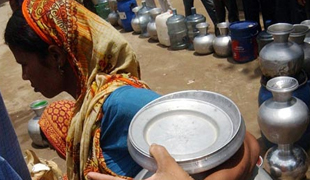Safe drinking water disappearing fast in Bangladesh
7 May 2013
Extreme weather increases salinity of water in coastal areas while excessive demand in Dhaka leaves dwindling supply
Syful Islam in Dhaka for the Thomson Reuters Foundation, part of the Guardian Development Network
guardian.co.uk
|
The availability of safe drinking water, particularly in Bangladesh's hard to reach areas, is expected to worsen as the country experiences the effects of climate change, experts say.
According to a study by the World Bank's water and sanitation programme (pdf), about 28 million Bangladeshis, or just over 20% of the population, are living in harsh conditions in the "hard-to-reach areas" that make up a quarter of the country's landmass. The study found that char – land that emerges from riverbeds as a result of the deposit of sediments – is among the most inaccessible, along with hilly areas, coastal regions and haors – bowl-shaped wetland areas in north-east Bangladesh. six months.
|

A Bangladeshi woman queues to collect drinking water from a temple in Dhaka, where potable water is in short supply. Photograph: PavelRahman/AP
|
"People living in hard-to-reach areas are often vulnerable to natural calamities like flooding, riverbank erosion and siltation," said Rokeya Ahmed, a water and sanitation specialist at the World Bank. "As a result of climate change, salinity in Bangladesh's coastal areas has increased [a great deal], causing a lack of sweet water. Women in coastal and haor areas need to go miles to collect a pitcher of safe drinking water."
Worsening weather extremes that bring floods, storm surges and cyclones are contributing to increases in water salinity and other problems accessing clean water, the report said. ShahdatHossain, a grocer in Matlab district, a hard-to-reach area about 50km (31 miles) from the capital, Dhaka, said his town is subject to regular riverbank erosion and flooding.
"Riverbank erosion has turned many people in this area into refugees," he said. "Since this area is very close to the Bay of Bengal, the amount of arsenic in the groundwater is also very high. We need to dig much deeper to get arsenic-free water."
Experts expect the struggle to find potable water to intensify during the summer. Shareful Hassan, a consultant on geographic information systems and a researcher on the World Bank study, says surface water sources have already dried up in many parts of the country, which will have a heavy impact on access to drinking water, sanitation and ecosystems.
"In the drought-prone Barind Tract area in north Bangladesh, you have to dig more than 350 metres to get safe drinking water," he said, adding that the situation is expected to worsen because unusually low rainfall in the area means underground aquifers are not being replenished.
Disappearing groundwater
Even in Dhaka, people have been reporting dwindling water supplies. EftekharulAlam, an engineer for the Bangladesh Agricultural Development Corporation, said groundwater levels in the city are falling drastically as a result of excessive extraction to meet its growing needs.
Dhaka's underground aquifers are usually recharged with water that percolates underground in nearby districts, but the levels of underground fresh water in those districts have also dropped, allowing seawater to start seeping into the aquifers. If this continues, experts say, Dhaka's drinking water could become increasingly undrinkable.
According to AinunNishat, a climate change expert and vice-chancellor of Brac University in Dhaka, rainfall across Bangladesh has halved and become more unpredictable over the past five years. That has led to problems including growing salinity in groundwater.
"Salinity in the water of coastal areas has now reached over 20 parts per thousand, but the human body can only tolerate five parts per thousand," he said.
Nishat says the best option for drought- and saline-prone areas is to preserve rainwater in artificial ponds and distribute it to communities. He agrees with other experts that the government must turn to technology to provide drinking water.
Filtration and desalination plants are expensive, but experts say they offer the only chance to avert a looming crisis. Nishat suggests installing sand filter systems, in which hand pumps are used to suck water from artificial ponds through a filter that makes the water potable.
For those living in hard-to-reach areas, the search for a solution has become a matter of urgency. "We now frequently face cyclones and flash floods which cause the swamping of croplands by saltwater and put us in danger," said Shafiqul Islam, a farmer in Barisal, a southern Bangladesh district that the World Bank study categorised as "extremely" hard to reach. "Our lives are under severe threat. Getting safe drinking water has become a big challenge."
• Syful Islam is a journalist with the Financial Express newspaper, published in Dhaka
Source:
http://www.guardian.co.uk/global-development/2013/may/07/safe-drinking-water-disappearing-bangladesh

